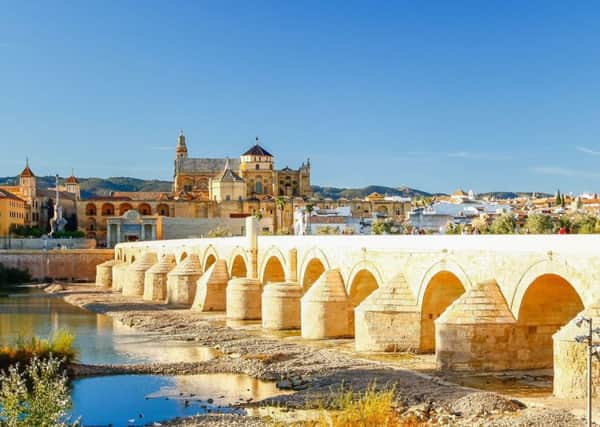Travel review: Moorish tastes in Andalucia


Luis Cernuda, the Spanish poet, said “If I was asked what single word sums up the thousand sensations, suggestions and possibilities that unite the radiant surface of Andalucia, I would say: happiness”. With the clearest of blue skies, fruits aplenty, phenomenal historic cultural diversity, fabulous rural landscapes and an attitude of ‘mañana, mañana’ (‘tomorrow, tomorrow’) it’s hard to disagree.
The Spanish even have the notion of puente (a bridge). They have their bank holidays on a Tuesday so that Monday will normally be treated as a bridge day (an extra day of holiday) ensuring a four-day weekend. And, as if that’s not enough, there’s even a viaducto (viaduct), which is when two holidays fall on Tuesday and Thursday enabling a whole week off.
Advertisement
Hide AdAdvertisement
Hide AdI had come to Córdoba whose jewel is unquestionably the Mezquita, the wonderful Muslim mosque. It’s serenity is heralded from afar by the belfry tower and closer by its large open courtyard that originally comprised of unpaved earth and irrigated citrus and palm trees. This delightful mosque cum cathedral is as beautiful and singular as it was immense and important. While these days the services are for Catholics, at one time it was the greatest central place of prayer in the Muslim world with up to 20,000 male worshippers kneeling in unison. More than Mecca even. The mihrab, the semi-circular niche indicating the qibla (the direction to face when praying) has wonderful artistry with carving surrounds depicting first vegetal, then geometric patterns and finally Arabic lettering. Exquisite.
The mosque’s ceramics come from Turkey, the roofs have stalactite-inspired designs and there is a beguiling painting of a somewhat effeminate Raphael, the protecting angel of the city. But the real joy are the rows and rows of cleverly aligned diagonal columns throughout the interior comprising of red and white striped arches with their special indented style known as ‘polylobulated’. A great place for hide and seek.
What’s so lovely to see throughout the city, though tough going on the feet, are the pebbled mosaic paving stones in a style known as ‘chinoiserie’. What’s attractive is that they are planted sideways and were originally taken in their smooth form from the river Guadalquivir, the only great navigable river in Spain, that has a bend close to the city centre: one of the reasons for Córdoba’s origin along with the silver deposits.
And on I went to Granada. The two cities have striking similarities with an equally dominant attraction bearing the strong hallmarks of their Arabic forebears. Both cities are refreshingly not claustrophobic, partly from being set on rivers but especially as the escape to the countryside is visible throughout.
Advertisement
Hide AdAdvertisement
Hide AdGranada is a city of unusual topography, rich in contrast, with plains and mountains, hills and scrubland and the famous citadel of the Alhambra Palace. How refreshing that it is so stunningly preserved and lacking any of the modern day theme-park experience.
First are the towers affording wonderful views across the city and the fabulously preserved and intact arena with classical columns in which to play out a gladiatorial or bull-fighting fantasy.
Then there are the immaculately kept gardens (and a great restaurant with good food at a remarkably reasonable rate). Best to go across the footbridge to the Generalife, with its gardens of pine, cypresses and box topiary.
Thirdly there’s the Palace itself. What beautiful woodwork there is up on the ceiling of the Golden Room, what gorgeous stonework in the Fountain of Lions, and what wonderful carving. Like many beautiful places, and I was reminded of Venice in this regard, it is easy to forget the painstaking and often involuntary work that went into their creation. The Muslims have certainly left their mark in a magnificent way at Granada even if they are no longer so resident.
Advertisement
Hide AdAdvertisement
Hide AdDown I went to the city’s cathedral. The exterior has the vast though grimy façade beckoning all that’s so typical of Spanish church architecture. The white interior and the Greek Cross layout made it much more intimate and personal. In the side chapels the paintings depict blood and gore and the sculpture betrays the love of gold.
It’s important to grasp how much of a melting pot Andalucia truly is. Cave dwellers, Visigoths, Jews, Muslims, Romans, Catholics, Phoenicians, Greeks and converts came and forged a path of expression all of its own: that of flamenco. Most tourists end up at one of the region’s commercial spectacles known as tablaos. Beware of the Zambra (gypsy shows) set in the cave district of Sacromonte. They can be of dubious quality. Recitals are also held in flamenco clubs or peñas. Most towns have at least one peña and I went to one.
The evening possessed true ‘duende’: their word for having a certain soul, a heightened state of emotion, expression and authenticity. It is typically connected with flamenco and by the end of the evening I too was under its spell.
GETTING THERE
Classic Collection Holidays (0800 047 1064, classic-collection.co.uk) offers two nights at Hotel Carmen, Granada and two nights at Hospes Palacio del Bailio, Cordoba from £1,139 per person. Price based on two adults sharing on a bed & breakfast basis and includes private transfers and return flights from the UK to Malaga. Flights available from up to 22 UK airports.
Advertisement
Hide AdAdvertisement
Hide AdClassic Collection Holidays (0800 047 1064, classic-collection.co.uk) offers three nights at Hotel Carmen, Granada from £619 per person. Or three nights at Hospes Palacio del Bailio, Cordoba from £689 per person.
Price based on two adults sharing on a bed & breakfast basis and includes private transfers and return flights from the UK to Malaga. Flights available from up to 22 UK airports.